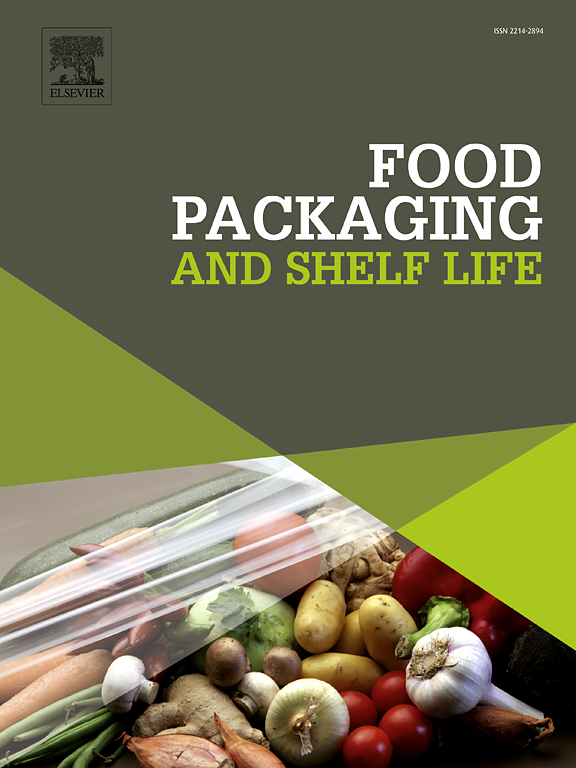Tannic acid-FeIII coated nanoparticles into Carboxymethyl chitosan/Pullulan polysaccharide films: Physicochemical, sustained release and antimicrobial properties
IF 8.5
1区 农林科学
Q1 FOOD SCIENCE & TECHNOLOGY
引用次数: 0
Abstract
This study aimed to investigate the impact of tannic acid-FeIII, a metallophenolic network (MPN), coated Litsea cubeba essential oil pectin-polylysine nanoparticles (MPN@PP-LNPs), on the properties of carboxymethyl chitosan/pullulan polysaccharide composite films (CC/PP films) prepared under acidic conditions. The CC/PP films were prepared at an optimal pH, and the physical, antioxidant, and antimicrobial properties were investigated with varying amounts of MPN@PP-LNPs. The results showed that a 9 % incorporation significantly enhanced the tensile strength (TS) and elongation at break (EB) of MPN-CC/PP films by 35.88 % and 26.5 %, respectively, and reduced the water vapor permeability (WVP) by 46 %, thereby, improving the water vapor barrier property. Additionally, it markedly enhanced the antimicrobial and antioxidant capabilities, effectively inhibiting E. coli and S. aureus, and augmented the antioxidant property by 10 times at pH 5.3. The freshness tests demonstrated that the film prolonged the shelf life of salmon, rendering it an appropriate option for active food packaging and preservation.
单宁酸- feiii包被纳米颗粒制备羧甲基壳聚糖/普鲁兰多糖薄膜:理化、缓释及抗菌性能
本研究旨在探讨金属酚网络(MPN)单宁酸-FeIII包覆的立方体香精油果胶-聚赖氨酸纳米粒子(MPN@PP-LNPs)对酸性条件下制备的羧甲基壳聚糖/木聚糖复合膜(CC/PP膜)性能的影响。在最佳 pH 值下制备了 CC/PP 薄膜,并研究了不同数量 MPN@PP-LNPs 的物理、抗氧化和抗菌特性。结果表明,9% 的添加量可显著提高 MPN-CC/PP 薄膜的拉伸强度(TS)和断裂伸长率(EB),分别提高了 35.88% 和 26.5%,并降低了 46% 的水蒸气渗透率(WVP),从而改善了水蒸气阻隔性能。此外,它还显著增强了抗菌和抗氧化能力,有效抑制了大肠杆菌和金黄色葡萄球菌,并在 pH 值为 5.3 时将抗氧化性提高了 10 倍。保鲜测试表明,这种薄膜延长了三文鱼的保质期,因此是活性食品包装和保鲜的理想选择。
本文章由计算机程序翻译,如有差异,请以英文原文为准。
求助全文
约1分钟内获得全文
求助全文
来源期刊

Food Packaging and Shelf Life
Agricultural and Biological Sciences-Food Science
CiteScore
14.00
自引率
8.80%
发文量
214
审稿时长
70 days
期刊介绍:
Food packaging is crucial for preserving food integrity throughout the distribution chain. It safeguards against contamination by physical, chemical, and biological agents, ensuring the safety and quality of processed foods. The evolution of novel food packaging, including modified atmosphere and active packaging, has extended shelf life, enhancing convenience for consumers. Shelf life, the duration a perishable item remains suitable for sale, use, or consumption, is intricately linked with food packaging, emphasizing its role in maintaining product quality and safety.
 求助内容:
求助内容: 应助结果提醒方式:
应助结果提醒方式:


